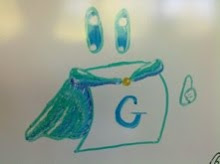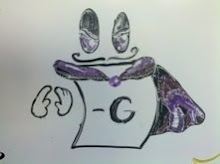Drew this on the board during the final exam for my freshman CGT seminar. :)

My CGT musings, with an emphasis on the computational complexity of games.
Drew this on the board during the final exam for my freshman CGT seminar. :)

In January, I played with a bunch of games starting with an empty board, but realized there was a simple symmetry strategy for the second player. We brainstormed some potential starting boards to fix things, but more complicated symmetry strategies arose.
After returning to Wittenberg, Noam Elkies and I corresponded, finally working out the current starting board. All the flaws we'd seen were fixed.
 My plan was to bring the game to Integers to play with people. Beforehand, I tested it out on my WittSem class, and it proved challenging. My student Patrick also took interest and showed a pseudo-symmetry strategy I was afraid of could be broken! Awesome! (I still don't recall how he does it!)
My plan was to bring the game to Integers to play with people. Beforehand, I tested it out on my WittSem class, and it proved challenging. My student Patrick also took interest and showed a pseudo-symmetry strategy I was afraid of could be broken! Awesome! (I still don't recall how he does it!)Some awesome quotes from today:
"Actually, I can say I played NoGo; I don't play Go!" -Aviezri Fraenkel
"'Every other weekend'? Other from what? What is the complement?" -Rebecca. ('Every other' is apparently not colloquial in Canada.)
"...and I am guilty of some of this research." -Florian Luca during his talk on Balancing Fibonacci Numbers. He went on to describe a problem as a mathematician trying to solve a system to find the street address for a party. :)
Last night, we had a little NoGo tourney between Canada, the US and Europe. Canada won, 5-4, but there may be a rematch tonight of sorts!
Today a lot happened. I talked and I listened to lots of games talks, many of which will become their own posts in the future. Instead, I'll quickly mention some highlights thus far.
Rebecca confused me yesterday by saying "in P" which I automatically translated as "efficiently solvable" instead of "in Zero". I had just met her, so I asked excitedly if she was in computer science. She said this misconception is even more dangerous because she is dealing with misere games, and need to consider both outcome classes. Those in Fuzzy when playing misere, but in Zero under normal play are in N-,P+, pronounced "NP" (which computational complexity theorists use for another well-studied complexity class). Dangerous!
I've also seen a great bunch of non-games talks, mostly number theory, which I've understood a bit of. Particularly, Carl Pomerance gave a talk I understood most of about product free subsets of the Naturals (if x and y are in S, then x*y is not in S... usually x*y (mod p)). Neil Hindman gave an impressive talk, mostly because I don't think he looked at any notes and covered a lot of complex stuff using only a whiteboard! I also found out yesterday that Beatty sequences/ratios were used to help discover quasicrystals, something which had a lot to do with this year's Nobel Prize! Wow!
I've mostly had a blast meeting people and playing games. While playing FLex with Marla yesterday, she commented, "This is all very important!" Everything I explained about what I was thinking was quickly absorbed by her and Rebecca. Awesome!
Meeting people---especially over games---is great! I played some impartial games with Yuval Tanny and Shira Giat. At one point I made a winning move, but was afraid I hadn't gotten the parity correct. Neil put me to ease, saying, "Yes, you counted to two correctly." That's about as high as I feel I can count these days.
Yuval and Shira are clearly awesome; this seems to be the norm for gamesters! There's a lot of energy in the group---all positive---especially from Jess Enright, who gave an awesome talk today about set representation games. Here is a picture of her realizing she won a game with Marla during the talk.

The first day of Integers has yielded many excellent number theory and combinatorics talks... which I didn't follow very well. After lunch, I spent much of the time playing FLex and Adjex with Alex Fink, Larry Rolen, Rebecca Milley and Marla Slusky, all of whom I just met today!
During lunch, Patrick played NoGo against Richard Nowakowski, winning two of three games! Afterwards, Richard said, "it's clear the american strategy is different from the canadian." Apparently in the states we play aggressively! ;)
With nine minutes left to go before the afternoon talks, Richard looked at Patrick and declared, "okay, one quick one!" Later, he explained, "there is no such thing as the last game."
Awesome!

The game begins with an invertible matrix of non-negative integers. Each turn ends with a player reducing one of the entries of the matrix, so that it is still a non-negative integer. If the resulting matrix is non-invertible, that is a losing move. Depending on how cutthroat you want to play, it might be up to the other player to notice you created a non-invertible matrix at the beginning of their turn.
I've played with my matrix algorithms class a few time|s this semester, using this as the starting position:
| 1 2 |
| 3 4 |
This position is in Fuzzy. What's the winning move?
Luckily, for CGT this has a simple solution: the game tree. Want to prove something about a specific position? Just draw out the game tree and label the options appropriately. Students should learn this as soon as possible; I broke the news to my freshmen class right away.
Bad news: I'm expecting rigorous proofs in this class.
Good news: these can be a proof by picture.
Unfortunately, I didn't do a great job teaching the basic requirements. We had problems with:
* Arrows to left/right options of a position. These were sometimes nearly vertical so it was impossible to discern whether they were for right or left arrows. Other times they pointed up, which is often very difficult to read.
* Not drawing all the options. We hadn't learned about dominated options yet, so all options should have been listed.
I think that the next time I teach this sort of course, I will have to be far more explicit about what makes a game tree. Also, I've done a good job this semester of using examples to motivate, but perhaps I didn't do enough examples of game trees.
if the nimbers for a game are bounded above, does this imply that there is an efficient algorithm, or shortcut, to evaluate impartial games?
 For positions with more than 3 options, this splitting can be done in a recursive fashion. Thus, games with any range of nimbers can be transformed into a game with maximum nimber of *2.
For positions with more than 3 options, this splitting can be done in a recursive fashion. Thus, games with any range of nimbers can be transformed into a game with maximum nimber of *2.

What did Fan Xie said?Yes, I certainly can elaborate! I did not get to know Fan Xie terribly well, except to help badger him into joining the NoGo tournament. (He nearly did not play! Luckily, Neil McKay is a persuasive individual!) I didn't pay a great amount of attention to Fan's games, aside from his game against the winning NoGo program. This was a wonderful match, because Fan spent too much time analyzing and explaining whether the computer's moves were good or not (and he did not write that program). Instead of focusing on winning, he was answering everyone else's questions, so the computer came out ahead.
How strong is he?
How did the program worked? (Monte Carlo?)
Can you elaborate on that ? :)

Players can not colour an arbitrary vertex but must proceed as follows: Player(If no adjacent moves are available, the next player immediately loses.)
1 begins the game and he must do it by colouring red a vertex adjacent to
the source. From this move and on, Player 2 must colour blue an uncoloured
vertex adjacent to the vertex last coloured red (i.e. coloured by Player 1), and
Player 1 replies by colouring red an uncoloured vertex adjacent to the vertex
that he coloured red last.

"Hard games give humans a chance to beat machines."If no efficient algorithm exists to determine who wins a game, then a program cannot always efficiently choose the best move to make. Hardness results are evidence that this is the case (although we still don't know that no efficient algorithm can solve NP-hard or PSPACE-hard problems). These games give us some sense of safety that the computer doesn't already have the game won.



